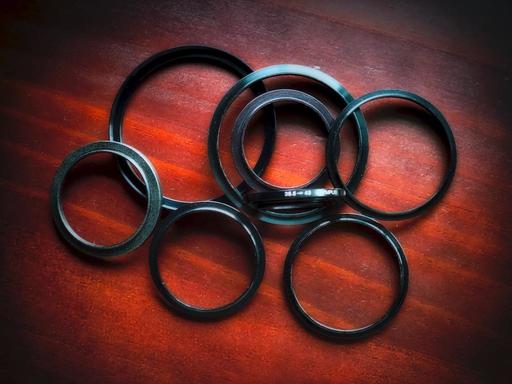Some photo accessories that never go out of style. For example, I have a stash of filters that I started collecting decades ago, many of which come in handy to this day.
My lenses over the years, however, have turned-over many times. When I shot Contax, 55mm and 67mm were the standard filter diameters. Then I switched to Canon, which favored 58mm and 77mm. Micro Four Thirds played small ball with much smaller rings, not to mention all of the vintage optics I have. Yet, I've maintained the same collection of filters as always. How could that be?
Step-up rings.
I have quite a collection of them, and they cost hardly anything. Yet when I have a filter or lens hood that I want to use, but the diameter is wrong, I always have a step-up or step-down ring that makes the whole thing work.
This is particular cost effective with large diameter polarizers that are expensive. I can repurpose my excellent 77mm multicoated circular on a 72mm lens no problem, thanks to, yes, a 72mm > 77mm step up ring. As long as I have those little beauties, nothing goes to waste in my filter box.
One other point that I want to make is that I have a few different camera kits. One of the things that I prefer is to have what I need in each kit without having to borrow from the other. Filters and lens hoods are at the top of that list. Nothing worse than need a neutral density optic and remembering that it's in the other bag.
Step up rings make this possible. I can utilize all my filters all the time regardless of their diameter. It's so efficient.
I've made some good investments over the years. But one of the most cost effective have been my collection of step up rings. Lenses may come and go. But rings are forever.
How to Get Started with Film Photography (eBook)
This 57-page eBook ($5.99) in universal PDF format provides an excellent introduction to film photography. Along with an abundance of illustrations, you'll learn how to:
- Find the right camera for you
- Choose the best film for your kind of photography
- Discover the lenses that you should add to your kit
- Learn the ins and outs of film processing
- Find out how to develop B&W film at home
- Master basic shooting techniques
- See how to care for your gear
- And more!
You can read How to Get Started with Film Photography on your computer, smartphone, tablet, and practically any other electronic device that displays PDFs. So you can always have it with you for reference.
Get up to speed quickly with film photography and start making beautiful images. Download How to Get Started with Film Photography today!
You can share your thoughts at the TDS Facebook page, where I'll post this story for discussion.












